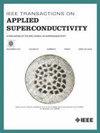Measurements of Heat Release Associated With the Mechanical Transients in Superconducting Magnets
IF 1.7
3区 物理与天体物理
Q3 ENGINEERING, ELECTRICAL & ELECTRONIC
引用次数: 0
Abstract
Transient release of heat due to cracking, interfacial debonding and conductor motion can lead to premature quenching and training in high-field superconducting accelerator magnets. Understanding the physical mechanisms behind the heat release and quantifying it for various impregnation materials and mechanical stress conditions is essential for eliminating the quench training phenomenon in future magnets. We have developed a system to perform simultaneous cryogenic measurements of stress-induced acoustic emissions (AE) and local temperature variations for samples of copper wire embedded in commonly used magnet impregnation materials, and we present initial test results for the epoxy CTD-101 K. The samples, monitored simultaneously by a shear-piezo transducer and a miniature temperature sensor, were installed in a variable-temperature cryogenic probe while mechanical stress was gradually applied using an external driver. We have found coincident AE and temperature spikes corresponding to cracking/debonding and slip-stick motion. We have estimated the heat released during the debonding event and reported initial efforts towards AE/thermal energy correlation.求助全文
约1分钟内获得全文
求助全文
来源期刊

IEEE Transactions on Applied Superconductivity
工程技术-工程:电子与电气
CiteScore
3.50
自引率
33.30%
发文量
650
审稿时长
2.3 months
期刊介绍:
IEEE Transactions on Applied Superconductivity (TAS) contains articles on the applications of superconductivity and other relevant technology. Electronic applications include analog and digital circuits employing thin films and active devices such as Josephson junctions. Large scale applications include magnets for power applications such as motors and generators, for magnetic resonance, for accelerators, and cable applications such as power transmission.
 求助内容:
求助内容: 应助结果提醒方式:
应助结果提醒方式:


